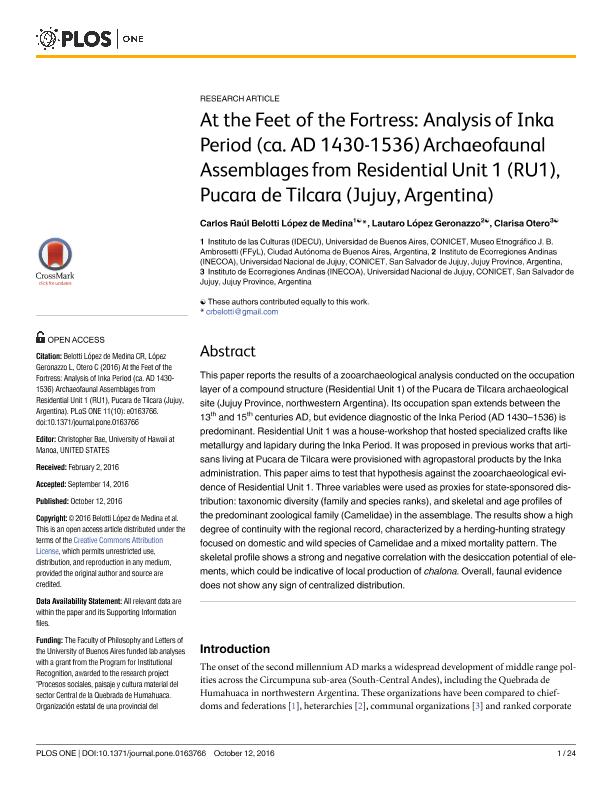Artículo
At the Feet of the Fortress: Analysis of Inka Period (ca. AD 1430-1536) Archaeofaunal Assemblages from Residential Unit 1 (RU1), Pucara de Tilcara (Jujuy, Argentina)
Fecha de publicación:
10/2016
Editorial:
Public Library of Science
Revista:
Plos One
ISSN:
1932-6203
Idioma:
Inglés
Tipo de recurso:
Artículo publicado
Clasificación temática:
Resumen
This paper reports the results of a zooarchaeological analysis conducted on the occupation layer of a compound structure (Residential Unit 1) of the Pucara de Tilcara archaeological site (Jujuy Province, northwestern Argentina). Its occupation span extends between the 13th and 15th centuries AD, but evidence diagnostic of the Inka Period (AD 1430–1536) is predominant. Residential Unit 1 was a house-workshop that hosted specialized crafts like metallurgy and lapidary during the Inka Period. It was proposed in previous works that artisans living at Pucara de Tilcara were provisioned with agropastoral products by the Inka administration. This paper aims to test that hypothesis against the zooarchaeological evidence of Residential Unit 1. Three variables were used as proxies for state-sponsored distribution: taxonomic diversity (family and species ranks), and skeletal and age profiles of the predominant zoological family (Camelidae) in the assemblage. The results show a high degree of continuity with the regional record, characterized by a herding-hunting strategy focused on domestic and wild species of Camelidae and a mixed mortality pattern. The skeletal profile shows a strong and negative correlation with the desiccation potential of elements, which could be indicative of local production of chalona. Overall, faunal evidence does not show any sign of centralized distribution.
Palabras clave:
Zooarchaeology
,
Humahuaca
,
Tilcara
,
Inka
Archivos asociados
Licencia
Identificadores
Colecciones
Articulos(SEDE CENTRAL)
Articulos de SEDE CENTRAL
Articulos de SEDE CENTRAL
Citación
Belotti López de Medina, Carlos Raúl; Lopez Geronazzo, Lautaro Nahuel; Otero, Clarisa; At the Feet of the Fortress: Analysis of Inka Period (ca. AD 1430-1536) Archaeofaunal Assemblages from Residential Unit 1 (RU1), Pucara de Tilcara (Jujuy, Argentina); Public Library of Science; Plos One; 10; 11; 10-2016; 1-24; e0163766
Compartir
Altmétricas




